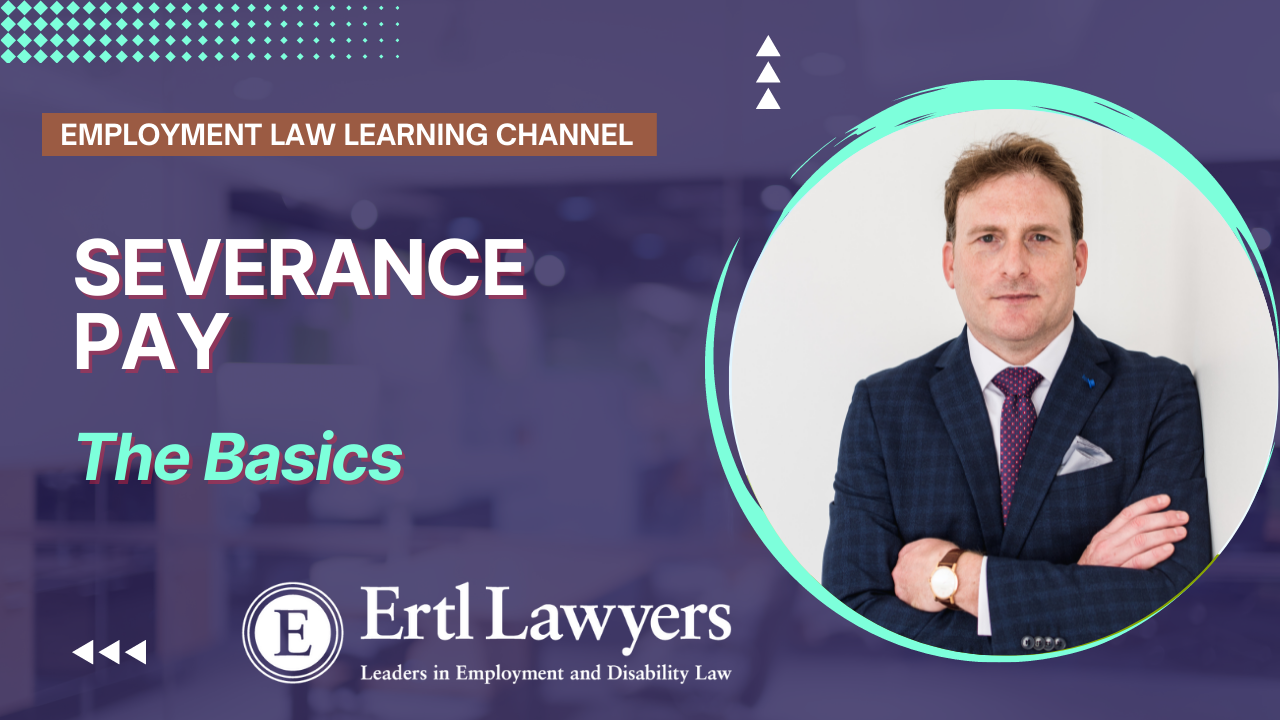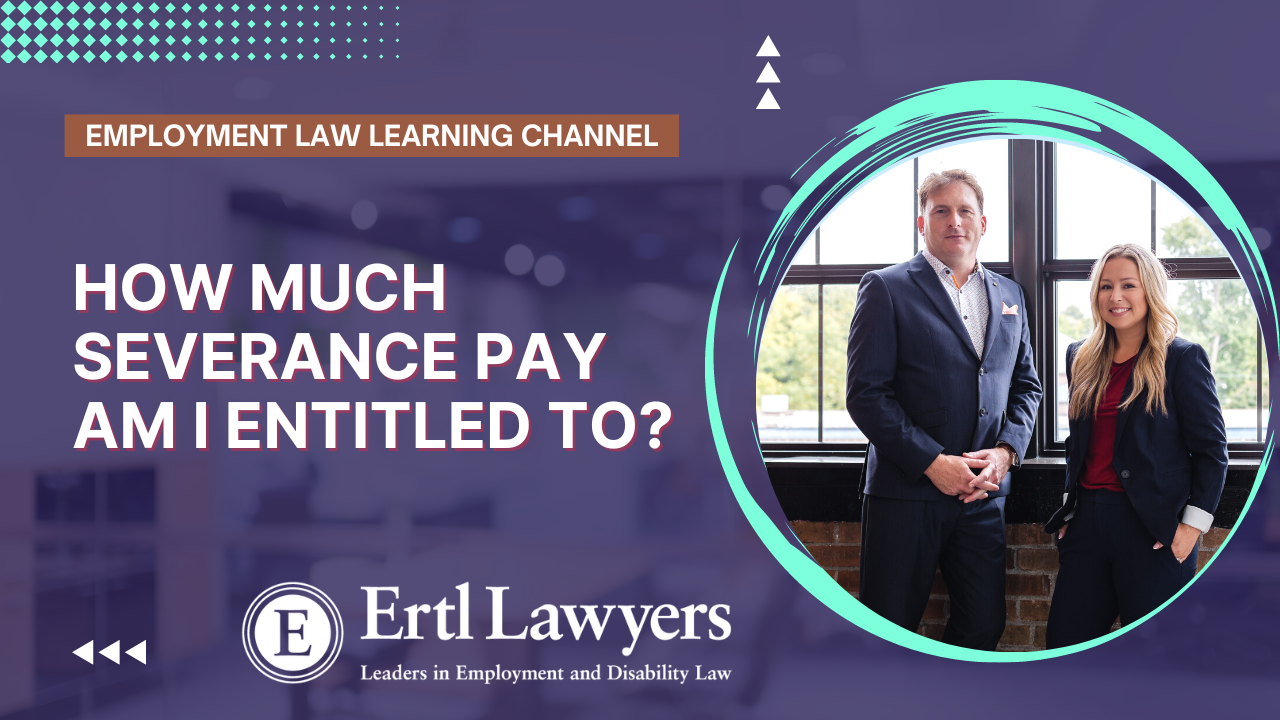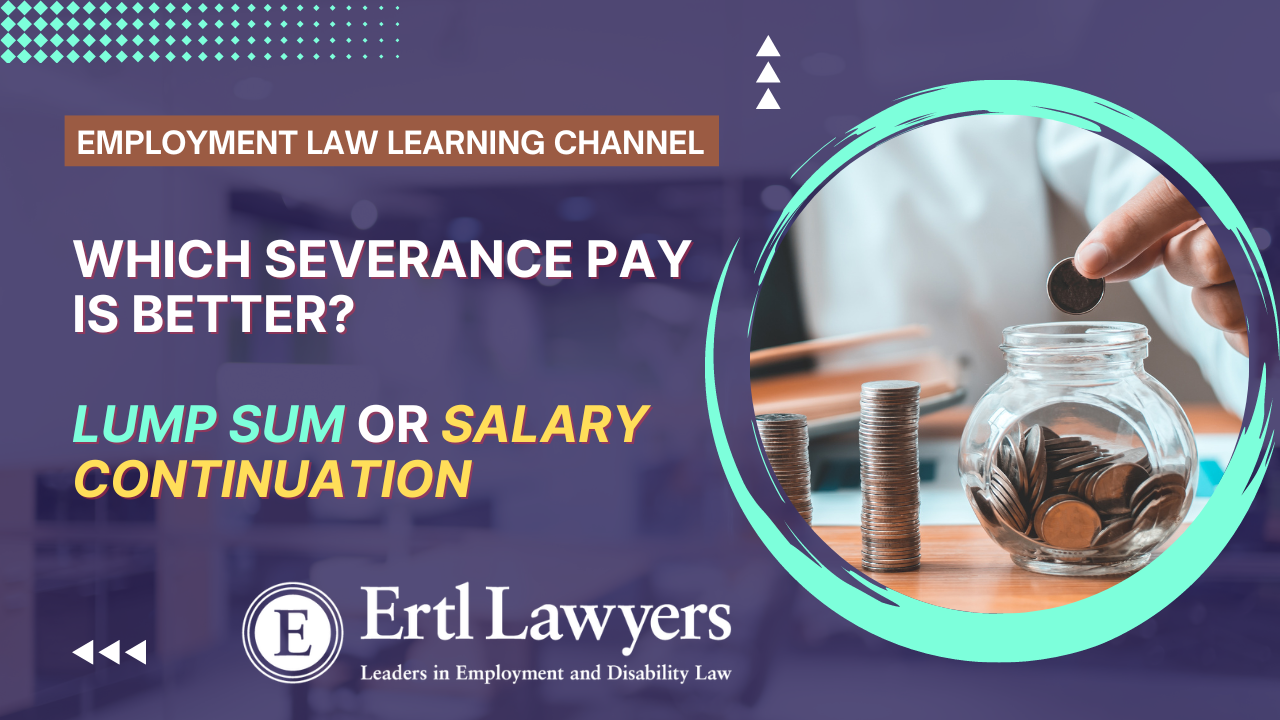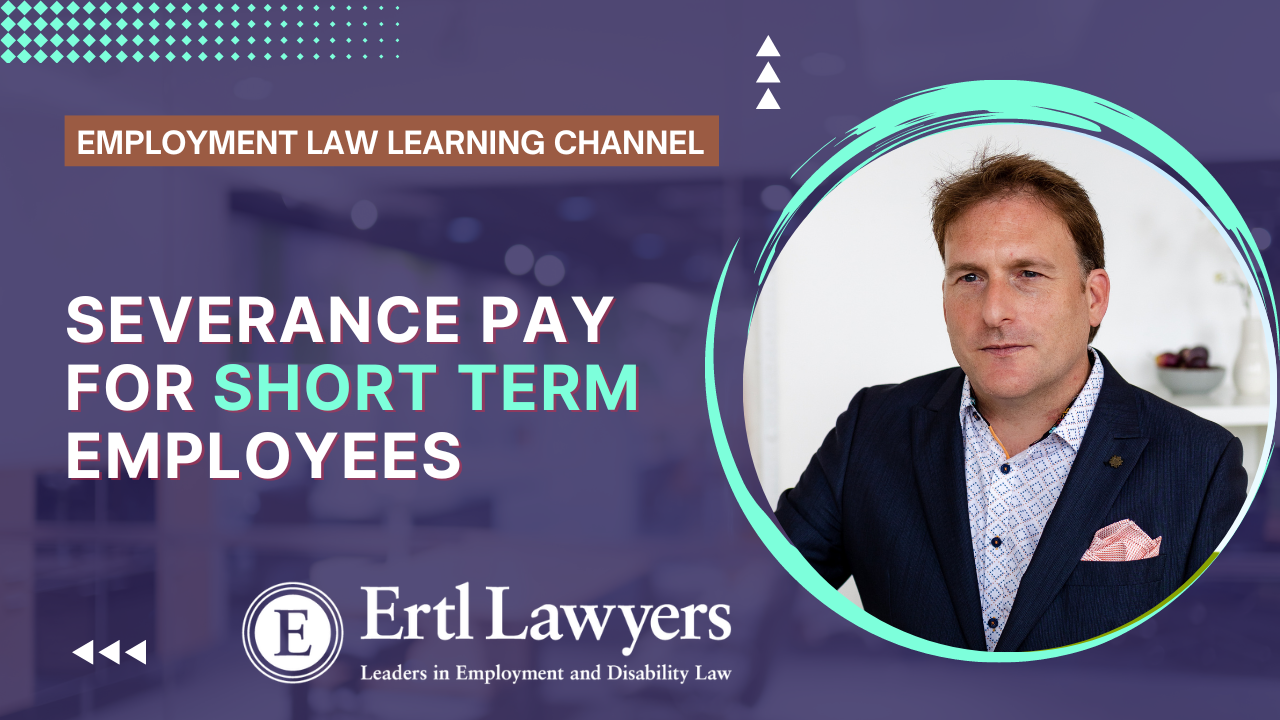Severance Pay in Ontario

How Much is Severance Pay in Ontario?
You are entitled to severance pay in Ontario if you have been fired without cause.
When an employee is terminated, they are provided working notice, pay in lieu of notice (which is often referred to as severance pay or termination pay), or a combination of both.
Severance pay in Ontario varies from individual to individual and can be as low as one week’s pay up to a maximum of about 24 months of pay.
Ertl Lawyers is a Toronto-based law firm. We offer service across the GTA and Ontario including: Windsor, London, Kitchener, Niagara Falls, St. Catharines, Hamilton, Guelph, Milton, Burlington, Oakville, Pickering, Ajax, Whitby, Oshawa, Kingston, and Ottawa.
We’ve negotiated thousands of severance packages and recovered millions in severance pay in Ontario for our clients.
Consult with us today to learn what you are entitled to.
For more severance pay resources:
- Try our severance calculator
- Watch our employment law videos on this site or our YouTube Channel
- Download a Free Guide
How is severance pay in Ontario calculated?
The amount of severance pay in Ontario is determined by Ontario’s Employment Standards Act (ESA) and the common law (which is the body of law created by our court system). We’ll discuss both below.
Severance Pay in Ontario (under the ESA)
Ontario’s ESA guarantees you the minimum amount of severance pay, calculated according to this formula:
| Years of Service | Amount Notice/ Pay in Weeks |
| 0-1 | 1 |
| 1-3 | 2 |
| 3-4 | 3 |
| 4-5 | 4 |
| 5-6 | 5 |
| 6-7 | 6 |
| 7-8 | 7 |
| 8 or more | 8 |
PLUS:
One week of pay for every year of service (up to a maximum of 26 weeks) but only if :
- You have 5 years or more of service; and
- Your company has an annual payroll of $2.5 million per year or more.
Example Calculation:
If Mary works for an employee for 6.5 years, and that employer has an annual payroll of more than $2.5 million, than she would be automatically entitled to 6 + 6.5 = 12.5 weeks of pay.
Compare: If Mary works for an employee for 6.5 years, and that employer does not have an annual payroll of more than $2.5 million, than she would be automatically entitled to just 6 weeks of pay.
Severance Pay in Ontario (under the Common Law)
“Common law” refers to the law that makes up our court system.
Whereas Ontario’s ESA provides minimum severance pay, the common law determines a person’s maximum entitlements.
Currently, the maximum amount of severance pay under the common law is about 24 months’ pay. In rare cases, it can be higher.
The key case that courts rely on to determine proper severance pay in Ontario is Bardal v. Globe & Mail Ltd. Bardal (and the hundreds of cases that followed in its footsteps) provides that the amount of severance pay must be based on a variety of personalized factors, including:
- age
- length of service
- type of job
- availability of jobs in the marketplace
Those are the main factors, but there are many more, including:
- employee’s health/disability
- poor economy
- specialized role
- limited skills/training
- you were induced to leave secure employment
- the manner of your dismissal
For a fast and easy way to calculate/estimate your potential severance pay in Ontario, try our Severance Pay Calculator.
How much severance pay am I entitled to?
The minimum severance pay in Ontario is determined by a strict formula set out in section 57 of Ontario’s ESA. It’s easy to determine.
However, the common law determines the maximum amount of severance pay in Ontario. Again, the common law considers things such as your age, length of service, the type of job you had, and the availability of similar jobs in the marketplace.
Some general principles apply:
- Older workers are typically entitled to more severance.
- Longer-serving employees are usually entitled to more severance.
- Managers are typically entitled to more severance than non-managers.
- If a particular industry is in recession, those workers might be entitled to more.
- Even short-service employees (with less than three years) can be entitled to disproportionately longer notice periods.
It’s always best to consult an employment lawyer who has handled thousands of wrongful dismissal matters. That’s us.
Is severance pay mandatory in Ontario?
With limited exceptions, when an employee is terminated without cause, Ontario companies must pay the minimum amounts prescribed by the Ontario ESA and more if the employee has a common law entitlement to even greater severance. The size of the company does not matter.
Federally regulated employees (such as employees who work for banks, airlines, etc.) are governed by the Canada Labour Code, which has its own formula for severance pay in Ontario.
Whether an employee has a common law entitlement to more severance may not be evident to someone who has been terminated. For that reason, you should contact us.
What is the minimum severance pay in Ontario?
Ontario’s ESA sets the minimum severance pay in Ontario. Section 57 of the ESA sets out a formula for calculating the minimum amounts of severance pay based solely on a person’s length of service.
What is the maximum severance pay in Ontario?
The maximum amount of severance pay in Ontario is determined by the common law, based on variables including your age, length of service, type of job you had, and the availability of similar jobs in the marketplace.
With rare exceptions, the maximum amount of severance pay in Ontario is roughly 24 months severance pay.
What should be in my severance pay package?
A complete severance package should consist of all forms of compensation you would have earned had you continued to work for your employer, including:
Salary
This should be the salary you earned at the time of your termination. The common law would also consider any salary increases you were expecting.
Commissions
Absent any contractual language to the contrary, you should be entitled to commissions you earned (but were not paid) before your termination. You should also be entitled to the commissions you would have earned in the future.
Bonus
Absent any contractual language to the contrary, you should be entitled to bonuses you earned (but were not paid) before your termination. You should also be entitled to the bonuses you would have earned in the future.
Benefits
Under Ontario’s ESA, the employer should continue your benefit plan for the prescribed minimum period (somewhere between one and eight weeks). The common law, however, would demand that the employer continue your benefits for the full duration of the proper notice period. For example, if you are entitled to six months of severance, the benefits should be continued for six months too.
Other Entitlements
Generally speaking, the common law would also demand that the employer provide compensation in lieu of car allowance, cell phone, gym memberships, employee discounts, etc.
For a more in-depth discussion about severance packages, download our free guide “Understanding Your Severance Package.”
Do you get severance pay in Ontario if you are fired?
This depends on whether you were “fired” or “terminated” without cause or with cause.
You are generally entitled to severance pay in Ontario if you have been terminated without cause (i.e., no fault of your own).
If you have been terminated “with cause” or with “just cause” (e.g., you have engaged in some severe form of misconduct), you are not generally entitled to severance pay in Ontario.
It is not uncommon for employers to terminate “for cause” to avoid paying severance. That’s why it is always a good idea to consult with an experienced employment lawyer.
If I quit, am I entitled to severance pay in Ontario?
You might be entitled to severance pay if you quit for a good reason. For example, if you believe you were constructively dismissed, you might still have an entitlement to severance pay.
Common examples of constructive dismissal include a reduction in pay, a demotion, a reduction in responsibility, a geographic transfer, etc.
Otherwise, without a good reason, you are not generally entitled to severance pay in Ontario if you resign your employment.
Always consult an employment lawyer if you are contemplating quitting and think you might have been constructively dismissed. This is a complex area of the law.
How does my employment contract affect my severance pay in Ontario?
If your employment agreement has a termination provision, it might spell out precisely what you are entitled to at termination.
Sometimes, the termination provision might attempt to limit your severance pay to just the minimums under Ontario ESA – meaning you are not entitled to common law severance pay. Is this legal?! Yes. If the termination provision is clearly drafted and, as long as your severance entitlements in that termination provision don’t fall below the Ontario ESA minimums, you might be stuck with what your employment contract says.
Caution: For various technical reasons, these termination provisions are not enforceable. It is highly recommended that you contact us to have us review your employment agreement to determine your severance pay in Ontario entitlements.
How is severance pay in Ontario provided?
Lump Sum
Severance pay in Ontario can be paid out all at once. This is called “lump sum”.
Salary continuation
Sometimes, severance pay is paid as if you were still working there. You still get your regular paycheques but you don’t report to work.
Working notice
People don’t like to hear this, but the employer can provide severance as a working notice. For example, if you were entitled to three months of severance, the employer could make you work those three months instead of paying you a lump sum or providing salary continuation.
Combination
An employer can use a combination of working notice, lump sum, and salary continuation.
When is severance pay in Ontario provided?
The minimum severance payments under Ontario’s ESA must be paid quickly – within seven days of your termination or the next pay period, whichever is later.
Common law severance pay entitlements are usually negotiated and take longer to be paid.
Is severance pay taxable in Ontario?
Yes. Severance pay is income, so it is taxable in Ontario.
That said, there are differences in how a lump sum is paid vs. salary continuation.
With a lump sum, it is categorised as a “retiring allowance” under the Income Tax Act. The employer will withhold a portion of the gross amount under set rates. It will remit that percentage to the government. You get the rest. There are no deductions for E.I. or CPP.
With salary continuation, it’s as if you received pay cheques during the ordinary course. Federal and provincial taxes, E.I., CPP, etc. are deducted from your pay.
Severance pay and E.I.
If you receive severance pay (statutory, common law, or both), it must be reported to Service Canada. After all, severance pay is considered income.
Although you can (and should) apply for E.I. as soon as you are terminated, you won’t receive E.I. until your severance “runs out”.
Further, if you are already receiving E.I. by the time you negotiate a severance package, the E.I. you received will have to be paid back by you. The good news is that once the E.I. is paid back, your entitlement to E.I. is “re-set”.
Should I go to the Ministry of Labour to get my severance pay?
The Ministry of Labour’s job is to enforce the ESA. It can only get you the minimum severance proscribed by the ESA. It cannot get you more than the minimum. It cannot get you common law severance pay.
Moreover, if you file a complaint with the Ministry of Labour to get your severance, you will have waived your right to pursue greater severance at common law.
In some rare cases, it makes sense to complain to the Ministry. But you should always consult with an employment lawyer first.
How long do I have to claim for severance pay in Ontario?
The law imposes a general two-year time limit for you to pursue greater severance through the courts. There are some exceptions. Don’t wait to contact a lawyer. You could be giving up your rights.
If you are making a Ministry of Labour complaint instead, the current limit is also two years.
How do I get more severance pay in Ontario?
The best way to get more severance pay in Ontario is to consult with a lawyer (to see if you have a case)
If you have a case, the lawyer will first attempt to negotiate with your ex-employer.
If negotiations are not successful, you have the option of commencing a legal claim.
Less than 1% of wrongful dismissal matters ever see the inside of a courtroom.
Should I hire a severance pay lawyer?
Based on our experience, employees who try to negotiate their severance package often end up accepting less favorable terms than they deserve.
Although they may be able to negotiate a few additional weeks of pay, the outcome is almost always suboptimal compared to what an experienced employment lawyer can achieve.
Therefore, we recommend seeking the assistance of an experienced lawyer who can help you secure a better severance package.
Read more: read our reviews.
How much do severance pay lawyers cost?
Severance pay lawyers will charge either a contingency fee (a percentage of the improvement in your offer), a flat / fixed fee, or by the hour.
During our free consultation, we will discuss this with you in detail.
Severance Pay Calculator
Our severance pay calculator can give you an idea of how much your severance should be.

Ertl Lawyers negotiated a dramatic increase in my severance pay offer. It gave me great comfort and support until I found my next job. Thanks David!
– A.K., IT Professional, Mississauga
Need Expert Help With Your Severance Pay in Ontario?
When you contact us for a free consultation, we will thoroughly review your matter. We’ll tell you whether we believe you’re entitled to more severance pay than what your ex-employer is offering. We will also discuss expectations, timing, and costs with you. Our consultation is 100% comprehensive. It is designed to give you the information you need to make the best decision possible.
Employers and their legal counsel know that Ertl Lawyers are well-prepared to fight for our clients, which is why the majority of our matters are successfully negotiated without even having to start a legal claim.
We’d like to help you too. And, we believe that our help can make all the difference.
Related Blogs
What To Know About the Employment Equity Act in Canada
If you want a summary of the intent behind Canada's Employment Equity Act (EEA), you need not look any further than section 2 of the EEA, the "Purpose of Act" (last updated in 2017): "The purpose of this Act is to achieve equality in the workplace so that no person...
Performance Improvement Plans in the Banking Industry
At face value, performance improvement plans (PIPs) are meant to be a tool that helps struggling employees meet specific performance-related goals. In the banking and finance industry, this commonly means meeting targets and sales quotas of various financial products....
Working Notice in Ontario
Suppose an employer wants to end an employment contract without cause in Ontario, and the employee has worked with them for at least 90 days. In that case, the employee is entitled to a minimum amount of notice that their job will end on a specific date in the future...







